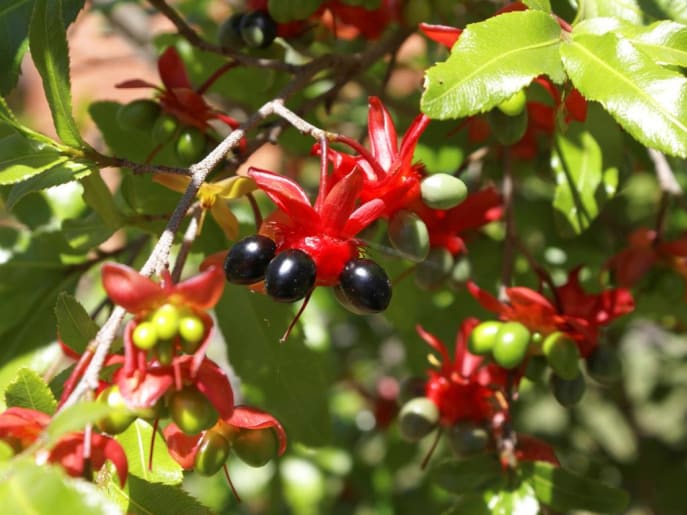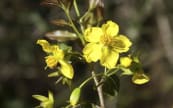Ochna, the Mickey Mouse plant (Ochna serrulata), is another example of an ornamental species escaping into bushland. A native of Africa, it has been widely planted in Australian gardens for its strikingly attractive flowers. It is a significant environmental weed in south-east Queensland, eastern areas of NSW and Lord Howe Island.
Description
Ochna grows as a shrub that is erect and woody up to about 1.5m high. Leaves are up to 5cm long, narrow and glossy with serrated margins. New growth usually has a bronze tinge. Flowers are bright yellow. The petals fall off, leaving the sepals, which turn scarlet red when the fruits appear. Fruits are initially green, turning glossy black in summer. Root is an angled tap root that is easily broken when hand pulled, hence Ochna easily reshoots.
Dispersal
Ochna serrulata has invaded roadsides, disturbed sites, waste areas, rainforests, forest margins, riparian areas and dry sclerophyll forests. Seed is spread by water, animals (foxes and rabbits), birds and humans, in contaminated soil (earthmoving equipment, car tyres, etc.) and by dumping garden waste into bushland. Locally, Ochna is easily dispersed to new areas when birds eat the fruits and spread the seeds. It forms dense thickets that are hard to remove, and it competes with native plants.
Removal
For young seedlings, hand pulling from down where the seedlings come out of the ground is generally the most successful method of control. Take care not to break the tap root. Larger individuals may need to be grubbed out with a mattock.
Grow Me Instead
- Native Fuschia (Correa species and cultivars) – There are many attractive species and cultivars of the native Correa. Most tolerate drought and poor soils, although some of the larger species, such as Correa lawrenceana, typically grow in moist situations. All have bell-shaped flowers that attract honeyeaters.
- Guinea flower (Hibbertia species) – With masses of bright yellow flowers, and easy to grow, several species of Hibbertia, e.g. Hibbertia empetrifolia, are commonly available from nurseries. Like most Australian native plants, they require good drainage.
- Pincushion Bush (Leucospermum species) – Several species and hybrids of these dramatic shrubs from southern Africa are available. They have flowers similar to the native Waratah, in shades of yellow, orange or red, which are produced in spring.
More information at www.helensburghlandcare.org.au or call Merilyn on 0414 819 742









